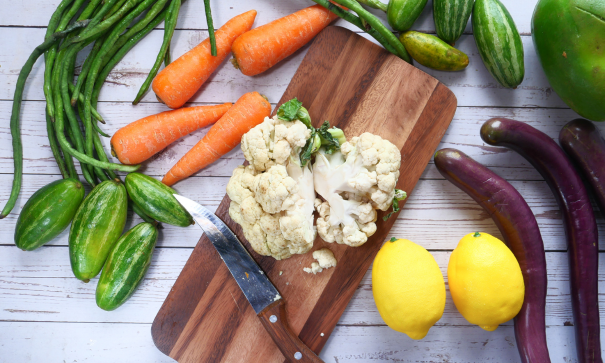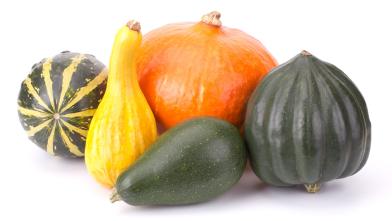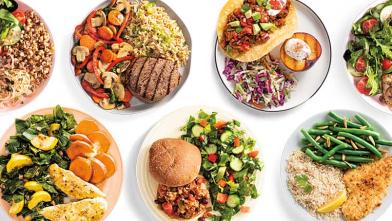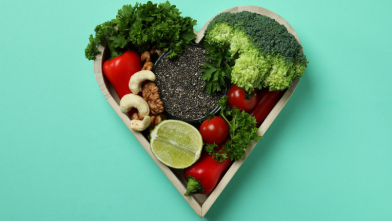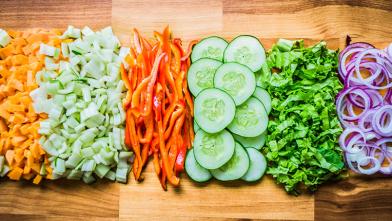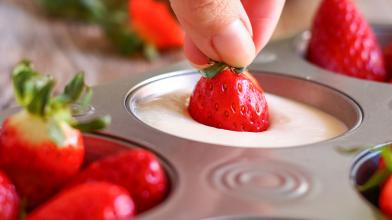Are you looking for new ideas on how to add more fruits and veggies to your meals to boost their flavor, nutrients, and blood glucose (blood sugar) management benefits? Here are 20 simple ones you can start trying right away, plus tips for buying produce and a breakdown of the different types!
Buying Produce
The first step in eating more fruits and veggies is buying more fruits and veggies. Many types of produce can be purchased fresh at the grocery store all year long. However, fresh produce is the tastiest and cheapest when you buy it in season. To save even more money and extend the life of your produce, try frozen or canned varieties. Just be sure when buying canned produce to choose fruits packed in their own juice or water (not syrup) and choose low-sodium or no-salt-added canned veggies.
The Produce Breakdown
There are two types of vegetables: non-starchy and starchy. Non-starchy vegetables (like carrots, bell peppers, and onions) are full of vitamins, minerals, fiber, and phytochemicals. And with so few calories and carbs, you can enjoy as many of these as you want per meal and snack. The American Diabetes Association’s Diabetes Plate recommends filling half of your plate with non-starchy vegetables.
Starchy vegetables (like potatoes and corn) are higher in carbs and calories and are considered carbohydrate foods—which the Diabetes Plate recommends should only fill one-quarter of your plate.
Fruits are nutrition-packed choices, too, filled with fiber, vitamins, and minerals. Fruit is a quality carbohydrate food (like starchy vegetables) and fit in the one-quarter carb section of your Diabetes Plate. Fruit can also make a great snack or sweet treat. Check your blood glucose after eating different fruits to see how it responds and adjust portion sizes accordingly.
20 Ideas to Increase Your Produce Intake
Breakfast
1. This veggie wrap adds mushrooms, spinach, and scallions to the eggs. Try adding veggies to your eggs when cooking 2. Toss fresh or frozen fruits with Greek yogurt for a breakfast parfait. Remember to watch your portions as specified in the recipe.
3. Blend Greek yogurt, almond milk, and some frozen fruit for a filling breakfast smoothie.
4. Add tomatoes, onions, spinach, and mushrooms to a frittata. Bake it on the weekend and reheat slices for a quick breakfast all week long.
Lunch
5. Enjoy a hearty salad that features cooked root vegetables, such as this Bountiful Harvest Vegetable Salad.
6. Thinly shave raw vegetables and toss with dressing and a little bit of flavorful cheese for a fresh side salad.
7. Have a sweet & savory salad. Berries or citrus can play a starring role as an ingredient in salads and salad dressings.
8. Use three ingredients to make an easy side dish of grilled zucchini with feta cheese.
9. Stuff pita with lettuce, tomato, onion and cucumber in this cheese and veggie pita wrap.
Dinner
10. Add a fruity twist to protein entrées, such as this Apricot Glazed Chicken.
11. Sauté a blend of your favorite vegetables with olive oil and garlic for a side dish that’s ready in minutes.
12. Enjoy turkey meatballs and sauce over spaghetti squash or other vegetable “noodles.”
13. Try a new cuisine type, such as an Indian vegetarian dish. Our Indian Vegetable Curry recipe subs sweet potatoes for the regular variety.
14. Can you think of a vegetable you’ve never cooked? Try it tonight! Braised fennel or roasted radishes, anyone?
Snacks
15. Slice jicama, cucumber, and radishes and store them in easy-to-grab containers in your refrigerator.
16. Prepare individual veggie and dip cups for a grab and go veggie treat.
Dessert
17. When fresh fruits are in season, cut them up, freeze them, and blend into a homemade sorbet.
Frozen grapes can have the same texture as ice cream! Remember that 17 grapes are approximately 15 grams of carbohydrate.
19. Bake an oat-topped fruit crisp made from fresh berries, apples, or peaches.
20. Enjoy the delicious taste and smell of Baked Cinnamon Stuffed Apples.
